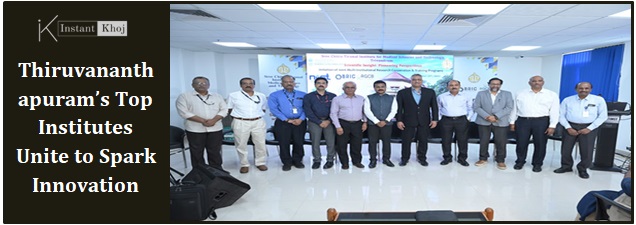Thiruvananthapuram, the capital city of Kerala, is witnessing a landmark moment for its scientific and technological ecosystem. Eight premier national research and academic institutions here have formally come together to collaborate across disciplines, sharing resources, and accelerating India’s innovation journey. The move is expected to strengthen regional infrastructure, enhance national research capacity, and provide new opportunities for students, scientists, and industry alike.
What’s the Collaboration About?
A memorandum of understanding (MoU) was signed recently among the following institutions:
-
Indian Institute of Science Education and Research, Thiruvananthapuram (IISER‑TVM)
-
CSIR‑National Institute for Interdisciplinary Science and Technology (CSIR‑NIIST)
-
Sree Chitra Tirunal Institute for Medical Sciences and Technology (SCTIMST)
These institutions will cooperate in interdisciplinary research, faculty and student exchange, joint academic programmes, and similar initiatives that encourage innovation and leveraging of combined capabilities.
The goals include:
-
Enhancing scientific cooperation among institutions
-
Promoting innovation by combining domain‑expertise from different research areas
-
Contributing to national research & development objectives
Who Was Involved and How It Happened
The MoU signing was a high‑profile event attended by major stakeholders from both the national and institutional levels, including:
-
Abhay Karandikar, Secretary, Department of Science and Technology (DST), Government of India
-
Kris Gopalakrishnan, President, SCTIMST
-
Sunil Kumar, Head, Autonomous Institutions Division, DST
Also present were institutional heads:
-
E. Magesh (C‑DAC)
-
Chandrabhas Narayana (RGCB)
-
J. N. Moorthy (IISER)
-
N. V. Chalapathi Rao (NCESS)
-
G. Byju (CTCRI)
-
C. Anandharamakrishnan (CSIR‑NIIST)
-
Dipankar Banerjee (IIST)
-
Dr. Sanjay Behari and Dr. Harikrishna Varma (SCTIMST)
This gathering signals that the collaboration isn’t merely aspirational, but backed by leadership and administrative will. The institutions represent diverse domains—earth sciences, space technology, biotechnology, medical sciences, agriculture, high‑performance computing, etc.—giving the partnership a rich base.
Why It’s Significant
This collaboration is particularly noteworthy for several reasons:
-
Interdisciplinarity
By bringing together institutions covering different scientific and technical fields, this initiative fosters cross‑domain innovation. It means that breakthroughs can happen at the interfaces—say, biotech + AI, space science + materials engineering, medical device innovation, etc. -
Resource Sharing & Efficiency
Individual institutions often have niche or specialized equipment, labs, or expertise. Pooling those will reduce duplication, allow better utilization, and make high‑end facilities more accessible to a broader set of researchers. -
Student & Faculty Growth
Exchange of faculty and students means exposure: students in biotechnology can learn from space science, or vice versa; cross‑mentorship; broadened perspectives. Joint academic programmes can be more attractive, globally competitive. -
Boost to National R&D Goals
India has ambitions in research, innovation, self‑reliance (ex: AtmaNirbhar), and competitiveness. Such partnerships help in scaling up capacity, increasing publications, patents, deep tech startups, and also contribute toward scientific outputs aligned with national needs. The collaboration helps Kerala’s capital contribute more robustly. -
Innovation Ecosystem Strengthening Regionally
Thiruvananthapuram has long had many research institutions, but they often function more independently. Formal collaboration helps build a stronger local ecosystem, which can be a magnet for funding, talent, startups, and private‑industry partnerships.
Related Initiatives in Thiruvananthapuram & Kerala
This isn’t the first time institutions in Thiruvananthapuram or Kerala have worked to foster innovation. These include:
-
TrEST Park (Trivandrum Engineering Science & Technology Research Park): Serves as a bridge between academia, industry, and startups, enabling deep‑tech innovation, mentorship, and real‑world problem solving.
-
Digital University Kerala (DUK) collaborating with IISER‑TVM for joint academic and research programs in data science, electronics, etc.
-
Govt Women’s College in Thiruvananthapuram getting a Centralised Instrumentation & Research Lab to support advanced research projects.
-
RGCB’s MoU with IHRD (Institute of Human Resources Development) for biotechnology & human resource training.
-
Schools signing up for Atal Tinkering Labs to introduce innovation from school level.
These show that the new institutional collaboration is part of a larger trend in the region to reinforce education, R&D, innovation ecosystems.
What the Collaboration Will Likely Do: Expected Outcomes
Based on what’s been announced, and comparable models elsewhere, here are some likely outcomes over short, medium, and long term:
Time Frame | Possible Outcomes |
|---|---|
| Short (1‑2 years) | Initiation of joint research projects; creation of shared labs or instrumentation facilities; student & faculty exchange; joint workshops/seminars; seed funding or pilot collaborative projects. |
| Medium (3‑4 years) | Joint degree programmes (Masters/PhD) across institutions; new patents, startup spin‑offs; more interdisciplinary publications; committees to manage shared resources; possibly joint centres of excellence. |
| Long (5+ years) | Thiruvananthapuram can emerge as a regional/national hub of innovation across multiple verticals; stronger private sector R&D investment; sustained funding; innovation outcomes that have economic, societal impact (health tech, agriculture, environment, etc.). |
Challenges to Watch Out For
While promising, collaborations of this kind often face challenges. Some likely ones here:
-
Coordination & Governance
Aligning priorities among eight institutions with different mandates, resource levels, leadership styles can slow progress. -
Funding & Sustainability
Shared labs, research grants, resource maintenance require consistent funding. Ensuring enough budget, proper cost sharing, and long‑term support is crucial. -
Intellectual Property (IP) Management
When multiple institutions work together, clarity on who owns what, benefit sharing, licensing, commercialization rights must be firmly laid out. -
Infrastructure Disparities
Some institutions may have newer labs, better capacity; others may be less well resourced. Balancing capacity building so that all partners benefit equitably will be important. -
Talent Retention & Capacity
To keep student & faculty collaborations meaningful, incentives, support, mentorship must be strong. Else, brain drain or under‑utilization could occur.
Real‑World Impacts & Possible Innovation Areas
Given the expertise of member institutions, some domains that are likely to benefit include:
-
Biotechnology & Life Sciences (RGCB, SCTIMST) — could translate to new diagnostics, therapeutics, bio‑manufacturing.
-
Agriculture & Crop Science (CTCRI) — enhanced tuber crop research, food security, climate‑adapted crops.
-
Space Science & Remote Sensing (IIST, NCESS) — satellite data, earth observation, climate modelling.
-
Computing, AI & Big Data (C‑DAC, IISER) — applying machine learning & high performance computing for health, environment, disaster forecasting.
-
Medical Technology & Healthcare Innovations (SCTIMST) — medical devices, biomedical engineering, patient care innovations.
Quotes & Reactions
Officials have made it clear that this is more than just symbolic:
-
Abhay Karandikar (DST) noted that it exemplifies “formalising” what many had done informally—sharing, collaboration—but now with institutional backing and cleaner governance.
-
Kris Gopalakrishnan (SCTIMST) emphasized the need for “strong scientific ecosystems,” saying that institutional synergy will help India meet global innovation benchmarks.
-
Sunil Kumar (Autonomous Institutions Division, DST) said this step will help strengthen India’s R&D output and help accelerate initiatives in deep tech and interdisciplinary work.
Why Thiruvananthapuram?
Thiruvananthapuram already has many advantages that make it suitable for becoming an innovation hub:
-
Concentration of high‑quality national research institutes in one city.
-
Growing infrastructure in education, research, biotech, computing etc.
-
Presence of Digital University, government interest in innovation, startup mission support.
-
A favorable living environment, reasonable cost compared to metro‑tier cities, and connectivity.
These factors help make collaboration more feasible and impact more visible.
Final Thoughts: A New Chapter for Innovation in Kerala
The joining of these eight top institutions in Thiruvananthapurammarks a turning point. It reflects a recognition that collaboration is essential in the modern era of science—and that solving complex problems requires combining expertise, infrastructure, and shared vision.
If managed well, this collaboration could result in breakthroughs that not only help Kerala, but also contribute significantly to India’s scientific standing globally. From improved health technologies to sustainable agriculture, from space‑based climate monitoring to biotechnology, the potential is vast.
The next few years will tell whether this partnership delivers on its promise. But one thing is clear: Thiruvananthapuram is stepping into the spotlight as an innovation center to watch.




